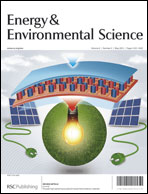Large-scale energy storage represents a key challenge for renewable energy and new systems with low cost, high energy density and long cycle life are desired. In this article, we develop a new lithium/polysulfide (Li/PS) semi-liquid battery for large-scale energy storage, with lithium polysulfide (Li2S8) in ether solvent as a catholyte and metallic lithium as an anode. Unlike previous work on Li/S batteries with discharge products such as solid state Li2S2 and Li2S, the catholyte is designed to cycle only in the range between sulfur and Li2S4. Consequently all detrimental effects due to the formation and volume expansion of solid Li2S2/Li2S are avoided. This novel strategy results in excellent cycle life and compatibility with flow battery design. The proof-of-concept Li/PS battery could reach a high energy density of 170 W h kg−1 and 190 W h L−1 for large scale storage at the solubility limit, while keeping the advantages of hybrid flow batteries. We demonstrated that, with a 5 M Li2S8 catholyte, energy densities of 97 W h kg−1 and 108 W h L−1 can be achieved. As the lithium surface is well passivated by LiNO3 additive in ether solvent, internal shuttle effect is largely eliminated and thus excellent performance over 2000 cycles is achieved with a constant capacity of 200 mA h g−1. This new system can operate without the expensive ion-selective membrane, and it is attractive for large-scale energy storage.

You have access to this article
 Please wait while we load your content...
Something went wrong. Try again?
Please wait while we load your content...
Something went wrong. Try again?


 Please wait while we load your content...
Please wait while we load your content...